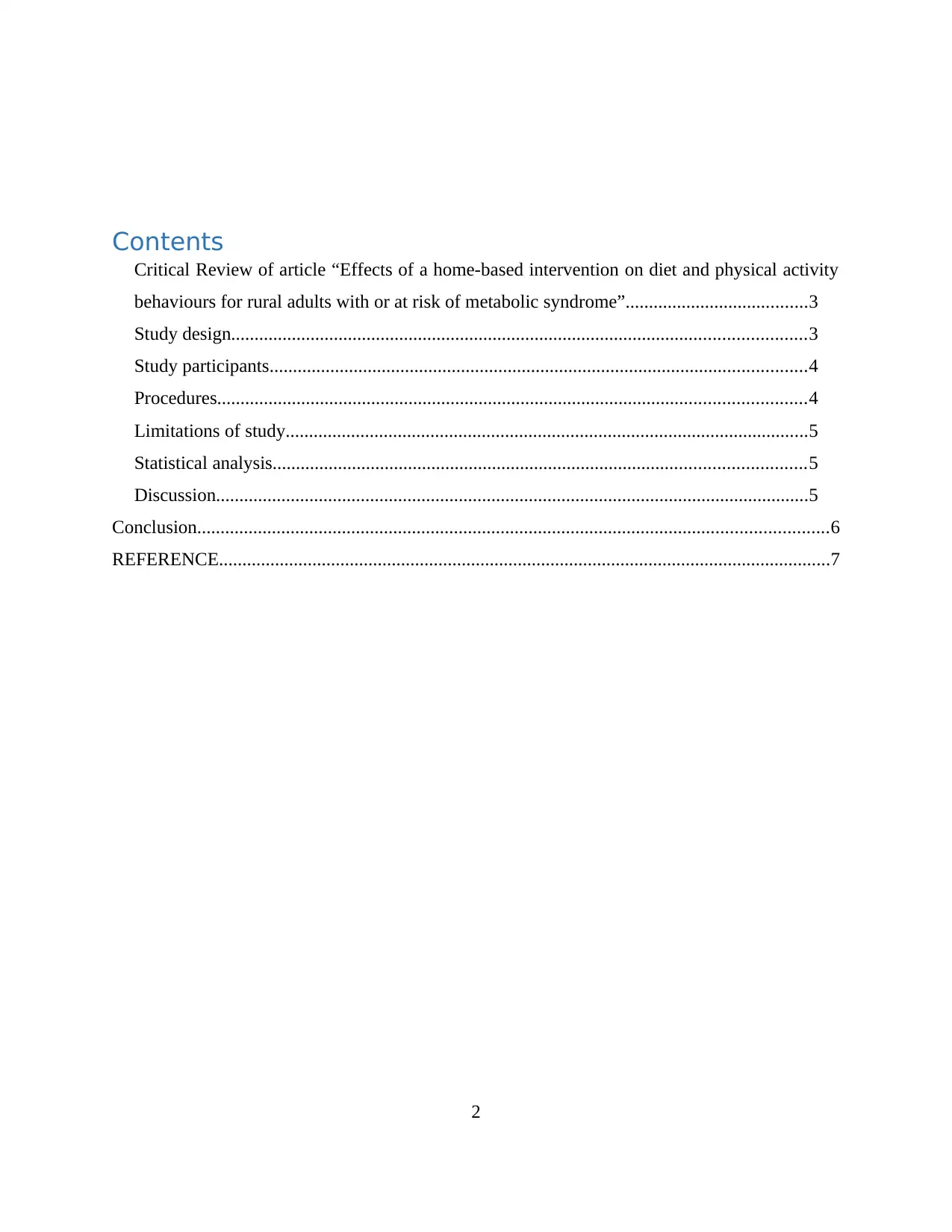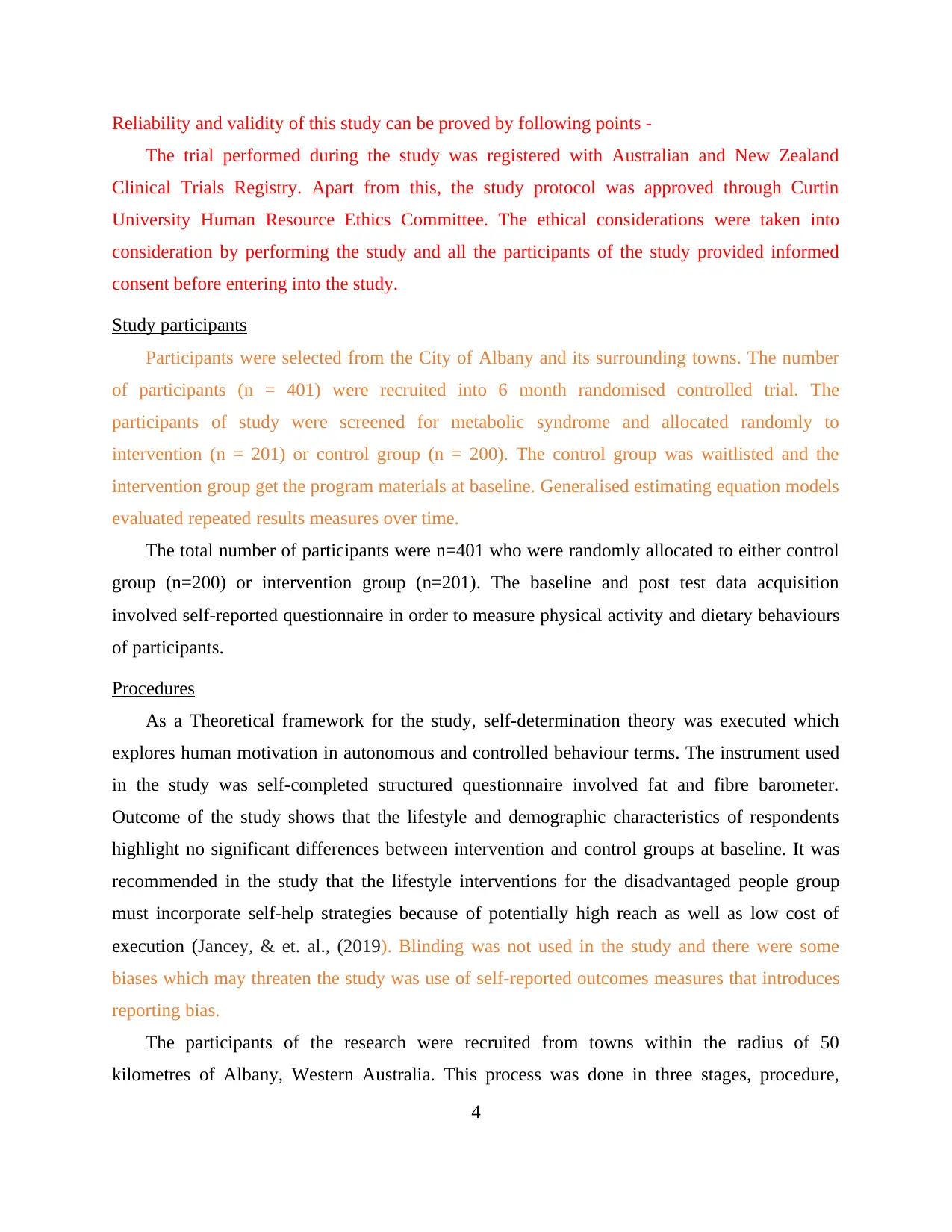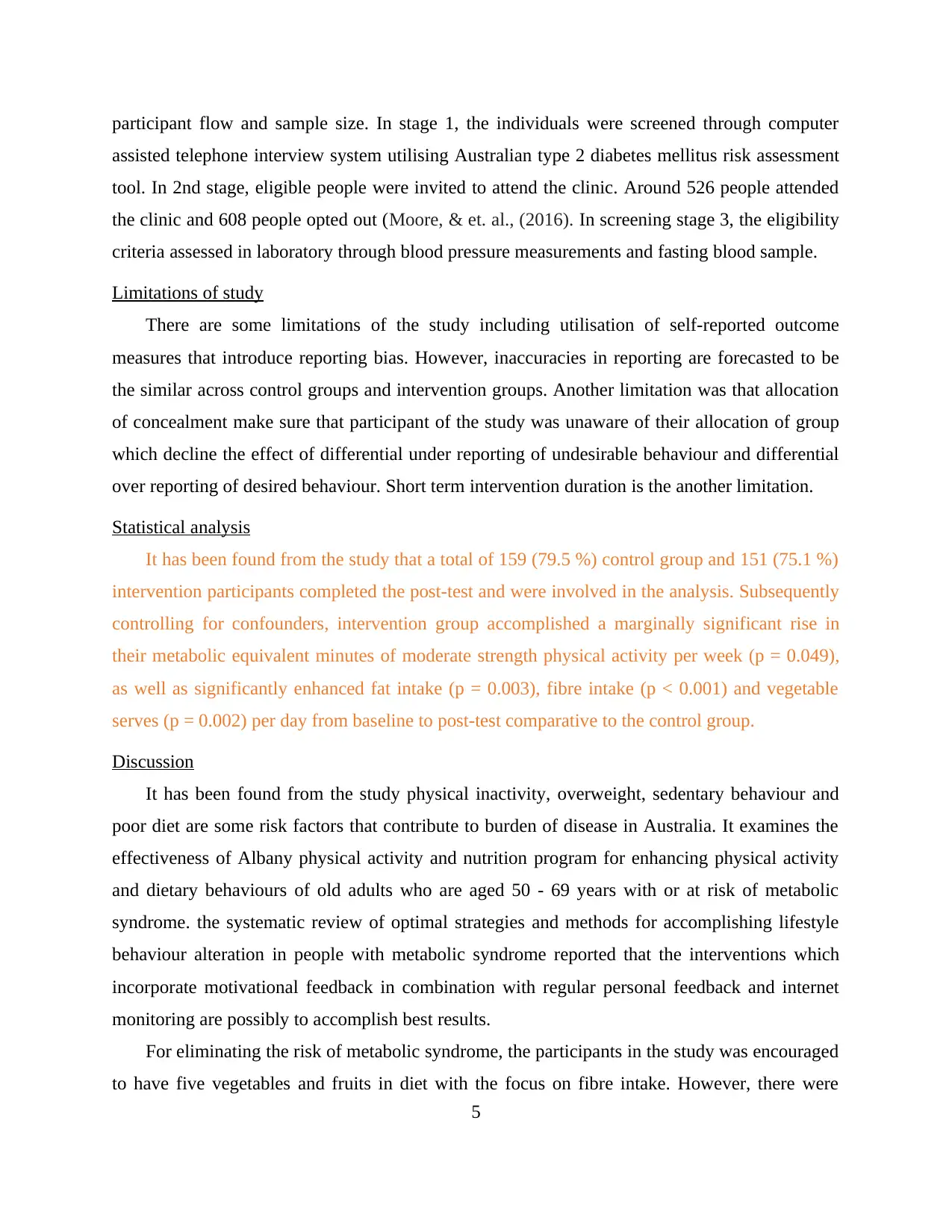Critical Review: Effects of Home Intervention on Rural Adults
VerifiedAdded on 2023/01/05
|7
|1556
|44
Report
AI Summary
This report presents a critical review of a randomized controlled trial investigating the effects of a home-based intervention on diet and physical activity behaviors in rural adults aged 50-69 years who are either at risk of or have metabolic syndrome. The study, conducted in Western Australia, aimed to determine if a six-month lifestyle intervention program, complemented by motivational interviewing, could improve health outcomes. The review covers the study design, participant selection, procedures, limitations, statistical analysis, discussion, and conclusions, highlighting the intervention's impact on physical activity, fat intake, fiber intake, and vegetable consumption. The study’s limitations, including self-reporting biases and short intervention duration, are also discussed. The review concludes that low-cost, home-based interventions with motivational support can effectively improve health behaviors in this population, addressing the challenges of providing healthcare in rural communities.

Critical Review
1
1
Paraphrase This Document
Need a fresh take? Get an instant paraphrase of this document with our AI Paraphraser

Contents
Critical Review of article “Effects of a home-based intervention on diet and physical activity
behaviours for rural adults with or at risk of metabolic syndrome”.......................................3
Study design...........................................................................................................................3
Study participants...................................................................................................................4
Procedures..............................................................................................................................4
Limitations of study................................................................................................................5
Statistical analysis..................................................................................................................5
Discussion...............................................................................................................................5
Conclusion.......................................................................................................................................6
REFERENCE...................................................................................................................................7
2
Critical Review of article “Effects of a home-based intervention on diet and physical activity
behaviours for rural adults with or at risk of metabolic syndrome”.......................................3
Study design...........................................................................................................................3
Study participants...................................................................................................................4
Procedures..............................................................................................................................4
Limitations of study................................................................................................................5
Statistical analysis..................................................................................................................5
Discussion...............................................................................................................................5
Conclusion.......................................................................................................................................6
REFERENCE...................................................................................................................................7
2

Critical Review of article “Effects of a home-based intervention on diet and
physical activity behaviours for rural adults with or at risk of metabolic
syndrome”
Study design
In this report, review of journal article named as “Effects of a home-based intervention on
diet and physical activity behaviours for rural adults with or at risk of metabolic syndrome: a
randomised controlled trial” is present. This report aims to review the article and the hypothesis
is There is significant relation between home based and diet and physical activity behaviours for
rural adults with or at risk of metabolic syndrome.
This research is done on people of age group 50 – 69 years. There is risk of metabolic
syndrome in these adults. These people are residents of Western Australian community. The P
value for this study is 0.95 significance level.
The article which is reviewed in the project is based on effects of home based intervention
on physical activity and diet behaviour for rural adults which or at risk of metabolic syndrome.
The main aim of the study is to determine whether home based lifestyle intervention program of
6 months complemented by motivational interviewing could and hence the diet and physical
activity behaviour in the people who aged 50-69 years with risk of metabolic syndrome or at risk
of metabolic syndrome, who are residing in disadvantaged rural Western Australian community
(Brown, & et. al., (2015). This research article was published in year 2016 and the authors of the
article are Krysten Blackford, Jonine Jancey, Anthony James, Tracy Waddell, Andy H. Lee and
Peter Howat. It was a randomised controlled trial study in which the data were gathered from
intervention and control groups at post-test and baseline test.
Metabolic syndrome is metabolic abnormalities that involves increased level of triglyceride,
hypertension, abdominal obesity, reduced high density lipoprotein cholesterol and
hyperglycaemia. The people with metabolic syndrome are at increased risk of developing
chronic disorders like cardiovascular disease, type 2 diabetes etc. It has been found from the
study that the residents of remote and rural Australia experience high rate of mortality and
morbidity as well as have less access to services than the people residing in metropolitan areas
(Blackford, & et. al., (2016). These populations are more possibly to be overweight, having high
blood cholesterol, insufficiently active and comprise more individuals aged over 65 years.
3
physical activity behaviours for rural adults with or at risk of metabolic
syndrome”
Study design
In this report, review of journal article named as “Effects of a home-based intervention on
diet and physical activity behaviours for rural adults with or at risk of metabolic syndrome: a
randomised controlled trial” is present. This report aims to review the article and the hypothesis
is There is significant relation between home based and diet and physical activity behaviours for
rural adults with or at risk of metabolic syndrome.
This research is done on people of age group 50 – 69 years. There is risk of metabolic
syndrome in these adults. These people are residents of Western Australian community. The P
value for this study is 0.95 significance level.
The article which is reviewed in the project is based on effects of home based intervention
on physical activity and diet behaviour for rural adults which or at risk of metabolic syndrome.
The main aim of the study is to determine whether home based lifestyle intervention program of
6 months complemented by motivational interviewing could and hence the diet and physical
activity behaviour in the people who aged 50-69 years with risk of metabolic syndrome or at risk
of metabolic syndrome, who are residing in disadvantaged rural Western Australian community
(Brown, & et. al., (2015). This research article was published in year 2016 and the authors of the
article are Krysten Blackford, Jonine Jancey, Anthony James, Tracy Waddell, Andy H. Lee and
Peter Howat. It was a randomised controlled trial study in which the data were gathered from
intervention and control groups at post-test and baseline test.
Metabolic syndrome is metabolic abnormalities that involves increased level of triglyceride,
hypertension, abdominal obesity, reduced high density lipoprotein cholesterol and
hyperglycaemia. The people with metabolic syndrome are at increased risk of developing
chronic disorders like cardiovascular disease, type 2 diabetes etc. It has been found from the
study that the residents of remote and rural Australia experience high rate of mortality and
morbidity as well as have less access to services than the people residing in metropolitan areas
(Blackford, & et. al., (2016). These populations are more possibly to be overweight, having high
blood cholesterol, insufficiently active and comprise more individuals aged over 65 years.
3
⊘ This is a preview!⊘
Do you want full access?
Subscribe today to unlock all pages.

Trusted by 1+ million students worldwide

Reliability and validity of this study can be proved by following points -
The trial performed during the study was registered with Australian and New Zealand
Clinical Trials Registry. Apart from this, the study protocol was approved through Curtin
University Human Resource Ethics Committee. The ethical considerations were taken into
consideration by performing the study and all the participants of the study provided informed
consent before entering into the study.
Study participants
Participants were selected from the City of Albany and its surrounding towns. The number
of participants (n = 401) were recruited into 6 month randomised controlled trial. The
participants of study were screened for metabolic syndrome and allocated randomly to
intervention (n = 201) or control group (n = 200). The control group was waitlisted and the
intervention group get the program materials at baseline. Generalised estimating equation models
evaluated repeated results measures over time.
The total number of participants were n=401 who were randomly allocated to either control
group (n=200) or intervention group (n=201). The baseline and post test data acquisition
involved self-reported questionnaire in order to measure physical activity and dietary behaviours
of participants.
Procedures
As a Theoretical framework for the study, self-determination theory was executed which
explores human motivation in autonomous and controlled behaviour terms. The instrument used
in the study was self-completed structured questionnaire involved fat and fibre barometer.
Outcome of the study shows that the lifestyle and demographic characteristics of respondents
highlight no significant differences between intervention and control groups at baseline. It was
recommended in the study that the lifestyle interventions for the disadvantaged people group
must incorporate self-help strategies because of potentially high reach as well as low cost of
execution (Jancey, & et. al., (2019). Blinding was not used in the study and there were some
biases which may threaten the study was use of self-reported outcomes measures that introduces
reporting bias.
The participants of the research were recruited from towns within the radius of 50
kilometres of Albany, Western Australia. This process was done in three stages, procedure,
4
The trial performed during the study was registered with Australian and New Zealand
Clinical Trials Registry. Apart from this, the study protocol was approved through Curtin
University Human Resource Ethics Committee. The ethical considerations were taken into
consideration by performing the study and all the participants of the study provided informed
consent before entering into the study.
Study participants
Participants were selected from the City of Albany and its surrounding towns. The number
of participants (n = 401) were recruited into 6 month randomised controlled trial. The
participants of study were screened for metabolic syndrome and allocated randomly to
intervention (n = 201) or control group (n = 200). The control group was waitlisted and the
intervention group get the program materials at baseline. Generalised estimating equation models
evaluated repeated results measures over time.
The total number of participants were n=401 who were randomly allocated to either control
group (n=200) or intervention group (n=201). The baseline and post test data acquisition
involved self-reported questionnaire in order to measure physical activity and dietary behaviours
of participants.
Procedures
As a Theoretical framework for the study, self-determination theory was executed which
explores human motivation in autonomous and controlled behaviour terms. The instrument used
in the study was self-completed structured questionnaire involved fat and fibre barometer.
Outcome of the study shows that the lifestyle and demographic characteristics of respondents
highlight no significant differences between intervention and control groups at baseline. It was
recommended in the study that the lifestyle interventions for the disadvantaged people group
must incorporate self-help strategies because of potentially high reach as well as low cost of
execution (Jancey, & et. al., (2019). Blinding was not used in the study and there were some
biases which may threaten the study was use of self-reported outcomes measures that introduces
reporting bias.
The participants of the research were recruited from towns within the radius of 50
kilometres of Albany, Western Australia. This process was done in three stages, procedure,
4
Paraphrase This Document
Need a fresh take? Get an instant paraphrase of this document with our AI Paraphraser

participant flow and sample size. In stage 1, the individuals were screened through computer
assisted telephone interview system utilising Australian type 2 diabetes mellitus risk assessment
tool. In 2nd stage, eligible people were invited to attend the clinic. Around 526 people attended
the clinic and 608 people opted out (Moore, & et. al., (2016). In screening stage 3, the eligibility
criteria assessed in laboratory through blood pressure measurements and fasting blood sample.
Limitations of study
There are some limitations of the study including utilisation of self-reported outcome
measures that introduce reporting bias. However, inaccuracies in reporting are forecasted to be
the similar across control groups and intervention groups. Another limitation was that allocation
of concealment make sure that participant of the study was unaware of their allocation of group
which decline the effect of differential under reporting of undesirable behaviour and differential
over reporting of desired behaviour. Short term intervention duration is the another limitation.
Statistical analysis
It has been found from the study that a total of 159 (79.5 %) control group and 151 (75.1 %)
intervention participants completed the post-test and were involved in the analysis. Subsequently
controlling for confounders, intervention group accomplished a marginally significant rise in
their metabolic equivalent minutes of moderate strength physical activity per week (p = 0.049),
as well as significantly enhanced fat intake (p = 0.003), fibre intake (p < 0.001) and vegetable
serves (p = 0.002) per day from baseline to post-test comparative to the control group.
Discussion
It has been found from the study physical inactivity, overweight, sedentary behaviour and
poor diet are some risk factors that contribute to burden of disease in Australia. It examines the
effectiveness of Albany physical activity and nutrition program for enhancing physical activity
and dietary behaviours of old adults who are aged 50 - 69 years with or at risk of metabolic
syndrome. the systematic review of optimal strategies and methods for accomplishing lifestyle
behaviour alteration in people with metabolic syndrome reported that the interventions which
incorporate motivational feedback in combination with regular personal feedback and internet
monitoring are possibly to accomplish best results.
For eliminating the risk of metabolic syndrome, the participants in the study was encouraged
to have five vegetables and fruits in diet with the focus on fibre intake. However, there were
5
assisted telephone interview system utilising Australian type 2 diabetes mellitus risk assessment
tool. In 2nd stage, eligible people were invited to attend the clinic. Around 526 people attended
the clinic and 608 people opted out (Moore, & et. al., (2016). In screening stage 3, the eligibility
criteria assessed in laboratory through blood pressure measurements and fasting blood sample.
Limitations of study
There are some limitations of the study including utilisation of self-reported outcome
measures that introduce reporting bias. However, inaccuracies in reporting are forecasted to be
the similar across control groups and intervention groups. Another limitation was that allocation
of concealment make sure that participant of the study was unaware of their allocation of group
which decline the effect of differential under reporting of undesirable behaviour and differential
over reporting of desired behaviour. Short term intervention duration is the another limitation.
Statistical analysis
It has been found from the study that a total of 159 (79.5 %) control group and 151 (75.1 %)
intervention participants completed the post-test and were involved in the analysis. Subsequently
controlling for confounders, intervention group accomplished a marginally significant rise in
their metabolic equivalent minutes of moderate strength physical activity per week (p = 0.049),
as well as significantly enhanced fat intake (p = 0.003), fibre intake (p < 0.001) and vegetable
serves (p = 0.002) per day from baseline to post-test comparative to the control group.
Discussion
It has been found from the study physical inactivity, overweight, sedentary behaviour and
poor diet are some risk factors that contribute to burden of disease in Australia. It examines the
effectiveness of Albany physical activity and nutrition program for enhancing physical activity
and dietary behaviours of old adults who are aged 50 - 69 years with or at risk of metabolic
syndrome. the systematic review of optimal strategies and methods for accomplishing lifestyle
behaviour alteration in people with metabolic syndrome reported that the interventions which
incorporate motivational feedback in combination with regular personal feedback and internet
monitoring are possibly to accomplish best results.
For eliminating the risk of metabolic syndrome, the participants in the study was encouraged
to have five vegetables and fruits in diet with the focus on fibre intake. However, there were
5

some barriers identified to vegetable and fruit intake involving perception that enough serves of
vegetables and fruit were consumed and difficulty changing habits, low quality produce, lack of
variety and lack of time to prepare. There were some problems too for this study that have
resulted in evaluating the right kind of vegetables and fruits that should be consumed by people
for maintaining their health and diet. It is recommended by the author in the study that
interventions must give practical solutions to address the barriers mentioned above and develop
strategies to communicate recommended serves of vegetables and fruits effectively to the
participants (Gray, & et. al., (2019).
Conclusion
As per the above provided review of the article, it has been concluded that Rural and remote
communities are neglected in lifestyle intervention research. A low cost, home based
intervention along with motivational support can help in effectively improving the dietary
behaviour and physical activity of adults who are aged 50 - 69 years residing in disadvantaged
rural area, with or at risk of metabolic syndrome. The biases in the study can be removed from
the study by providing each participant with the equal chance of being selected.
6
vegetables and fruit were consumed and difficulty changing habits, low quality produce, lack of
variety and lack of time to prepare. There were some problems too for this study that have
resulted in evaluating the right kind of vegetables and fruits that should be consumed by people
for maintaining their health and diet. It is recommended by the author in the study that
interventions must give practical solutions to address the barriers mentioned above and develop
strategies to communicate recommended serves of vegetables and fruits effectively to the
participants (Gray, & et. al., (2019).
Conclusion
As per the above provided review of the article, it has been concluded that Rural and remote
communities are neglected in lifestyle intervention research. A low cost, home based
intervention along with motivational support can help in effectively improving the dietary
behaviour and physical activity of adults who are aged 50 - 69 years residing in disadvantaged
rural area, with or at risk of metabolic syndrome. The biases in the study can be removed from
the study by providing each participant with the equal chance of being selected.
6
⊘ This is a preview!⊘
Do you want full access?
Subscribe today to unlock all pages.

Trusted by 1+ million students worldwide

REFERENCE
Effects of a home-based intervention on diet and physical activity behaviours for rural adults
with or at risk of metabolic syndrome: a randomised controlled trial, 2016. [Online].
Available through: <https://ijbnpa.biomedcentral.com/articles/10.1186/s12966-016-0337-
2>
7
Effects of a home-based intervention on diet and physical activity behaviours for rural adults
with or at risk of metabolic syndrome: a randomised controlled trial, 2016. [Online].
Available through: <https://ijbnpa.biomedcentral.com/articles/10.1186/s12966-016-0337-
2>
7
1 out of 7
Related Documents
Your All-in-One AI-Powered Toolkit for Academic Success.
+13062052269
info@desklib.com
Available 24*7 on WhatsApp / Email
![[object Object]](/_next/static/media/star-bottom.7253800d.svg)
Unlock your academic potential
Copyright © 2020–2025 A2Z Services. All Rights Reserved. Developed and managed by ZUCOL.





